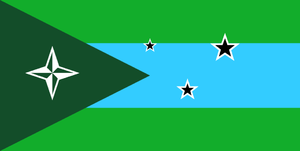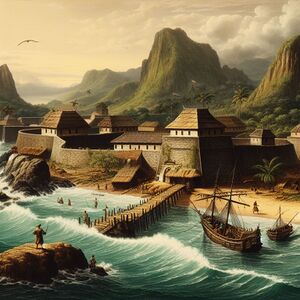Seváronsa
| Territory of Seváronsa Skírēn Seváronsa | |
 Flag | |
| Country | |
| Theme | |
| Capital and largest city |
Avrēdegra |
| Population | 776,732 |
| Governor | Sanovordus U.B.I. Iśikarin |
| President | Palladius Walowakuv (SU) |
| Legislature | Legislative Assembly |
| Stanora seats | 2 |
| Official languages | Kiravic Coscivian |
| Recognised languages | Portuguese, Barikol, Karluki |
| Postal Abbreviation | SVÁ |
| Time Zone | Central Cronan Time |
Seváronsa, officially the Seváronsa Territory is a federal subject of the Kiravian Federacy, occupying three islands in the Sea of Orixtal.
Geography
Seváronsa comprises three major islands: Lordaseváronsa ("Grand Seváronsa"), Lesser Seváronsa, and the more distant Karluk.
The territory has a tropical climate.
History
Seváronsa was first settled by the ancestors of the Barikol people. The Barikol people were tribally organised for most of their history. Their political development progressed such that territorial chiefdoms had begun to consolidate themselves in more densely populated areas of Great Seváronsa and Lesser Seváronsa by the time of colonisation.
St. Nicholas Colony
Main article: St. Nicholas Colony

Seváronsa was visited by traders of various nationalities early in the Age of Exploration, though Bergendii and Kiravians were the most frequent callers. The Bergendii navigator Jean-Zechariah Gullouing deLoreanne purchased the area enclosing a commodious natural harbour on Great Seváronsa from the native chief Bumi the Duped in exchange for an assortment of Levantine manufactures, including 11 leather boots (5 pairs and 1 lone right boot), four ear spoons, and two hats. There deLoreanne established a trading post and way station which he dubbed Havre de Grace. Burgundie achieved suzerainty over Great Seváronsa in 1654 and called it St. Nicholas Colony, which was later extended to the other two islands, which were collectively absorbed into the Burgoignesc Thalattocracy in 1876 after the unification of Burgundie following the First Fratricide.

St. Nicholas Colony was attacked by Kiravian naval forces and privateers several times during the Kiro-Burgoignesc Wars, but was never captured or occupied. It was, however, offered as a bargaining chip during peace negotiations to end War of St. Brendan's Strait and ceded to Kiravian control under the terms of the resulting Treaty of Kurst.
Kiravian rule
Under Kiravian rule, Seváronsa became an important part of the Kiravian maritime colonial and commercial network, serving as a way station for vessels travelling from Great Kirav and Æonara to the Kiravian holdings in Cusinaut (chiefly Rovaīon and Porfíria), and to various ports of call on the eastern seaboard of central and southern Crona. Coscivian settlers established plantations for various tropical crops, most prominently pineapple. A penal colony was founded on Karluk in [YEAR].
Government
Seváronsa is chartered overseas territory within the Kiravian Collectivity. Its governmental structure and fundamental laws are laid out by the Territorial Charter of Seváronsa, promulgated by Prime Executive Eridan Vriẍur and validated by the Stanora in [YEAR]. The Governor of Seváronsa is appointed by the Prime Executive of the Kiravian Federacy for a regular term of three years, though a Governor may be replaced or recalled at any point in their term. Gubernatorial appointments are renewable indefinitely, though the usual practice since 21156 has been to re-appoint any governor in good standing to a second three-year term, and no more. Similarly, while the appointment is a unilateral prerogative of the Prime Executive, it has become customary since the 21180s for Kroveniren Hall to solicit the advice of local legislative leaders during the nomination process.
The territorial legislative body is known as the Legislative Assembly (Áldaktorix Skráliuv). Like many and contemporary and historical legislatures in the Coscivian-dominated world, it is a part-time body that meets twice annually at [better tropical/local climatic equivalent of the vernal and autumnal equinoxes] for a period of X weeks. The Legislative Assembly comprises 23 seats, apportioned among the three islands according to population, with a guaranteed minimum of two seats intended to protect representation for Karluk. Each island's delegation to the LA is elected by single non-transferrable vote in a nonpartisan contest, as political parties are banned.
Seváronsa sends a single Delegate to the Federal Stanora. Although political parties are formally illegal and cannot operate in Seváronsa, candidates typically pledge to sit with one federal legislative caucus or another during their campaign. Since the end of Kirosocialism, Seváronsan Delegates have typically sat with either the Caritist Social Union or Coscivian National Congress, with all Seváronsan CNC Delegates voting as members of the Island Nation Party.
Law
Local Governance
Seváronsa is divided into four countyships (amtra). Two countyships (Co. Fayetev and Co. Bromelain) overlay Grand Seváronsa. Lesser Seváronsa falls under Seváronsa Countyship and Karluk falls under Karluk Countyship. Co. Karluk is a non-governing countyship where county-level services to civilian communities are provided directly by the provincial government. Its judicial and clerical services are organisationally fused with those of Seváronsa Countyship, but Co. Karluk remains a separate jurisdiction and has its own physical courthouse and registrar's office. The countyships are subdivided into parishes paroxin, with the exception of Avrēdegra, which is classified as a municipality (kivosar). The governing countyships have five-member legislative Commissions elected every 24 months by [how], and directly elected county executives elected every four years by alternative vote.
Society & Culture
Seváronsa has an ethnically diverse population that includes both Sea and Land Coscivians, Tropical Coscivians, Sarolastans and other Polynesians, Daxianese, Metzei, Lusonic people, Tierradureños, and Menquoi (particularly Bergendii). The Bergendii population numbers around 8,200 today, mostly living in Avrēdegra and its environs, although there are two Burgittan-speaking hamlets on Lesser Seváronsa. The population of Karluk is more uniformly Coscivian, owing to its history as a penal colony and the presence of a Kiravian military base.
A subculture of mostly low-income, traditionally rural-oriented, multi-generational Farakoskem known colloquially as errūbalmórya ("tree-crabs") exists on all three islands, but is especially prominent on Karluk and in the interior of Grand Seváronda. The errūbalmórya are mainly descended from former penal colonists and 19th century sailors. In contrast to the surrounding mainstream culture of the colony, the errūbalmórya became increasingly endogamous during the later half of the 20th century, and have petitioned for official recognition as a distinct Coscivian tuva.
Major religions include the Catholic Church (70% of the population), Chantrism, Æglasta-i-Xristul, Islam, Daxian folk religion, and Coconut Man Faith.

Economy
Seváronsa has a diversifying economy rooted in plantation agriculture and transitioning toward a service orientation. Tourism, sea and air transportation, real estate and land development, retail trade, and commercial fishing are the sectors contributing most to economic growth since 21190.
Seváronsa is outside of the Kiravian Main Customs Area. Its customs policy is governed by acts of the Stanora and special agreements with Alstin.